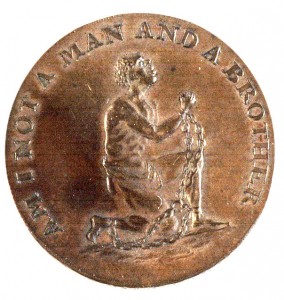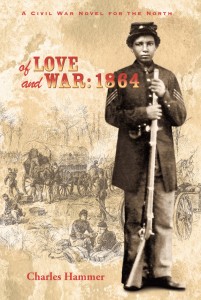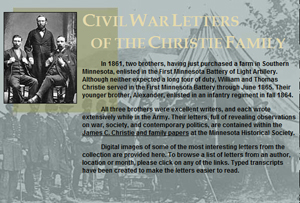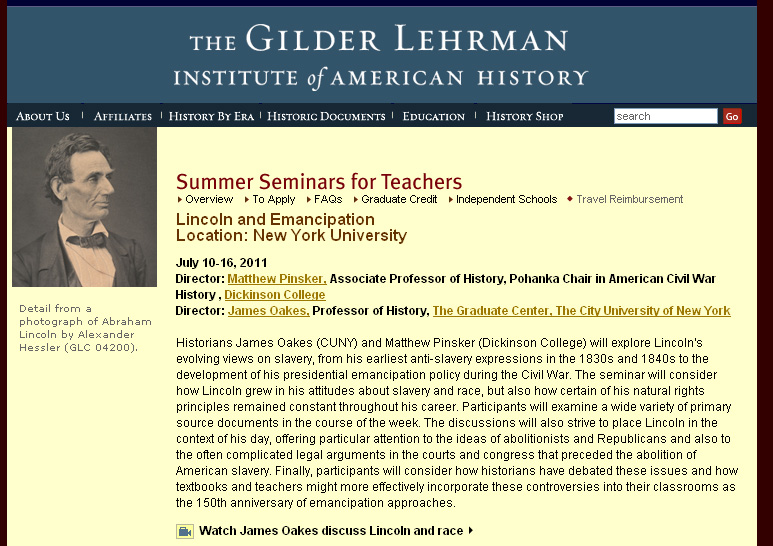 James Oakes and Matthew Pinsker will lead a seminar called “Lincoln and Emancipation” at New York University this summer from July 10 to July 16. The seminar will “will explore Lincoln’s evolving views on slavery, from his earliest anti-slavery expressions in the 1830s and 1840s to the development of his presidential emancipation policy during the Civil War.” Other information about this seminar is available here. If you want to attend, check this page for details on applying . The deadline is February 1, 2011. Oakes is a Professor of History at The City University of New York and received the Lincoln Prize for The Radical and the Republican: Frederick Douglass, Abraham Lincoln, and the Triumph of Antislavery Politics in 2008. Pinsker is the Pohanka Chair for Civil War History at Dickinson College and Director of the House Divided Project. You can watch Oakes discuss Lincoln and Race and Pinsker lead a discussion about Lincoln and the election of 1860 for a class at Dickinson College. The Gilder Lehrman Institute also offers a number of other seminars this summer, including The South in American History (June 26-June 30, 2011), The American Civil War: Origins and Consequences (June 19-25, 2011), and Reconstruction (July 17-23, 2011). A complete list of seminars is available here.
James Oakes and Matthew Pinsker will lead a seminar called “Lincoln and Emancipation” at New York University this summer from July 10 to July 16. The seminar will “will explore Lincoln’s evolving views on slavery, from his earliest anti-slavery expressions in the 1830s and 1840s to the development of his presidential emancipation policy during the Civil War.” Other information about this seminar is available here. If you want to attend, check this page for details on applying . The deadline is February 1, 2011. Oakes is a Professor of History at The City University of New York and received the Lincoln Prize for The Radical and the Republican: Frederick Douglass, Abraham Lincoln, and the Triumph of Antislavery Politics in 2008. Pinsker is the Pohanka Chair for Civil War History at Dickinson College and Director of the House Divided Project. You can watch Oakes discuss Lincoln and Race and Pinsker lead a discussion about Lincoln and the election of 1860 for a class at Dickinson College. The Gilder Lehrman Institute also offers a number of other seminars this summer, including The South in American History (June 26-June 30, 2011), The American Civil War: Origins and Consequences (June 19-25, 2011), and Reconstruction (July 17-23, 2011). A complete list of seminars is available here.
7
Jan
11
Oakes and Pinsker to Lead Gilder Lehrman Seminar for Teachers
Posted by sailerd Published in Civil War (1861-1865), Recent News, Video5
Jan
11
House Divided Launch & Civil War 150th, April 15-16, 2011
Posted by sailerd Published in Civil War (1861-1865), Recent NewsTo help honor the start of the 150th anniversary of the Civil War and to publicize the launch of a wide-ranging effort to help America’s classrooms learn more about this pivotal conflict, the House Divided Project at Dickinson College will host a weekend of entertaining and educational events, free of charge to participants:
1. Documentary Film Festival – Friday April 15, 2011, 7pm to 9pm
- Watch a fascinating collection of short documentary films about the Civil War and its impact on ordinary Americans and small communities such as Carlisle, Pennsylvania. Open to the public.
2. Teacher Workshop – Saturday April 16, 2011, 9am to noon
- Learn about the extraordinary range of free resources available online through the House Divided Project and other leading digital content providers. Advance registration required –open to K-12 educators and home-schooling parents.
3. Civil War Tours – Saturday April 16, 2011, 1pm to 3pm
- Experience Civil War walking tours as never before. Students and staff from House Divided will lead visitors around Carlisle using the latest digital tools to help create a truly unique glimpse into the past. Reservations encouraged.
4. David Blight Lecture – Saturday April 16, 2011, 7pm to 8:30pm
- Yale historian and author of Race and Reunion: The Civil War in American Memory (2001), David Blight will explore the meaning of the conflict at the beginning of its 150th anniversary. Book signing to follow. Open to the public.
All events are free
Questions? Contact Don Sailer at hdivided@dickinson.edu or 717-245-1525
17
Dec
10
History Now – Underground Railroad Essay
Posted by sailerd Published in Antebellum (1840-1861), Images, Recent ScholarshipThe Gilder Lehrman Institute recently published a new essay by House Divided co-director Matthew Pinsker in their December 2010 issue of History Now. As Pinsker explains in “The Underground Railroad and the Coming of War”:
“The Underground Railroad was a metaphor. Yet many textbooks treat it as an official name for a secret network that once helped escaping slaves. The more literal-minded students end up questioning whether these fixed escape routes were actually under the ground. But the phrase “Underground Railroad” is better understood as a rhetorical device that compared unlike things for the purpose of illustration. In this case, the metaphor described an array of people connected mainly by their intense desire to help other people escape from slavery. Understanding the history of the phrase changes its meaning in profound ways.”
You can read the full essay here. Other essays in this issue include “Lincoln’s Interpretation of the Civil War” by Eric Foner, “The Riddles of ‘Confederate Emancipation’” by Bruce Levine, and “Women and the Home Front: New Civil War Scholarship” by Catherine Clinton. All of the past issues of History Now are available here.
17
Dec
10
“Of Love And War: 1864: A Civil War Novel For The North”
Posted by sailerd Published in Civil War (1861-1865), Recent NewsCharles Hammer recently wrote a new novel entitled Of Love And War: 1864: A Civil War Novel For The North. As Hammer describes,
“The typical Civil War novel usually features a Confederate cavalier, often served by a loyal slave sidekick, who battles gallantly—for what? Actually, battling gallantly is all the South requires in such a book. Forget why we fought. “Of Love and War: 1864” strongly counters that view. It sends up the South of that era with, among accurate historical facts, a little-known verse the U. S. Colored Infantry sang in marching to war:
Away down South in the land of traitors,
Rattlesnakes and alligators,
Right away, come away, right away, Dixie land!
Where cotton’s king and men are chattels,
Union boys will win the battles….
In my story a peckerwood Georgia Militia deserter searches for the escaped slave girl he loves. He blunders into a firefight and gets captured by her. Now disguised as a man and enlisted as bluecoat sergeant in the U. S. Colored Infantry, she leads a wildcat black squad on one flank of Sherman’s march from Atlanta to the sea. They aim to emancipate slaves at plantations the army itself will not reach.”
You can learn more about this book on Amazon.com.
13
Dec
10
Civil War Letters of the Christie Family
Posted by sailerd Published in Civil War (1861-1865), Letters & Diaries, Recent Scholarship Themes: Battles & SoldiersThe Civil War Letters of the Christie Family at the Minnesota Historical Society offer an interesting perspective from three brothers who served in the Union army. Thomas and William Christie, who were both born in Ireland, enlisted in the First Minnesota Battery in 1861 and participated in the Vicksburg campaign as well as General William T. Sherman’s March to the Sea. Thomas had no difficulty in adjusting to “military life,” but noted that other soldiers in his regiment apparently found the transition to be a difficult one. “A great many of our men — and the Americans especially — cannot leave off those habits of Independence, which are so meritorious in the civilian, but so pernicious in the Soldier,” as Thomas observed. While they described their experiences during the war in detail, they also commented on contemporary political issues. William identified slavery as the cause of the conflict and supported President Lincoln’s Emancipation Proclamation. “For lighting the torch of Freedom,” William wrote that “the oppressed thoughout the land are this day Praying God to give us the victory.” Alexander, however, did not enlist until late 1864. After several months of training, his infantry regiment arrived in North Carolina in early April 1865 to participate in what he considered “the last great forward advancement of Sherman’s Army.”
In December 2010 the Minnesota Historical Society published a collection of these letters — Hampton Smith, Brother of Mine: The Civil War Letters of Thomas and William Christie (2010). “The letters are so engaging that one longs for more,”as a review in the Minneapolis – St. Paul Star Tribune notes. You can read the full review here.
10
Dec
10
Isaac L. Taylor at Gettysburg
Posted by sailerd Published in Civil War (1861-1865), Letters & Diaries Themes: Battles & Soldiers On July 2, 1863 at 5:40AM Isaac Taylor recorded in his diary that his regiment, the First Minnesota Volunteer Infantry Regiment, had arrived at Gettysburg. “Order from Gen. [John] Gibbon read to us in which he says this is to be the great battle of the war & that any soldier leaving ranks without leave will be instantly put to death,” as Taylor noted. By the end of the day 215 of the 262 soldiers in the regiment had been killed or wounded. While Isaac died, his brother, Patrick Henry Taylor, made it out of the battle without injury. After Patrick buried his brother, he added the final entry to the diary – Isaac had been “killed by a shell about sunset” and his grave was located “[about] a mile South of Gettysburg.” Four other Taylor brothers also served in other Union regiments during the Civil War. While Jonathan (Second Minnesota Battery of Light Artillery), Danford (Twelfth Illinois Cavalry), and Samuel (102nd Illinois Infantry) survived the war, Judson was in Company K of the Eleventh Illinois Cavalry when he died at Vicksburg on December 1, 1864. Isaac’s Taylor’s diary was published in the Minnesota History Magazine in 4 sections. You can download them as a PDF file: Part 1 ; Part 2 ; Part 3 ; Part 4. Several historians have studied the First Minnesota Volunteer Infantry, including John Quinn Imholte’s The First Volunteers; History of the First Minnesota Volunteer Regiment, 1861-1865 (1963), Richard Moe’s Last Full Measure: The Life and Death of the First Minnesota Volunteers (1993), and Brian Leehan’s Pale Horse at Plum Run: The First Minnesota at Gettysburg (2004). You can read another account of the regiment’s actions in James A. Wright’s No More Gallant a Deed: a Civil War Memoir of the First Minnesota Volunteers (2001).
On July 2, 1863 at 5:40AM Isaac Taylor recorded in his diary that his regiment, the First Minnesota Volunteer Infantry Regiment, had arrived at Gettysburg. “Order from Gen. [John] Gibbon read to us in which he says this is to be the great battle of the war & that any soldier leaving ranks without leave will be instantly put to death,” as Taylor noted. By the end of the day 215 of the 262 soldiers in the regiment had been killed or wounded. While Isaac died, his brother, Patrick Henry Taylor, made it out of the battle without injury. After Patrick buried his brother, he added the final entry to the diary – Isaac had been “killed by a shell about sunset” and his grave was located “[about] a mile South of Gettysburg.” Four other Taylor brothers also served in other Union regiments during the Civil War. While Jonathan (Second Minnesota Battery of Light Artillery), Danford (Twelfth Illinois Cavalry), and Samuel (102nd Illinois Infantry) survived the war, Judson was in Company K of the Eleventh Illinois Cavalry when he died at Vicksburg on December 1, 1864. Isaac’s Taylor’s diary was published in the Minnesota History Magazine in 4 sections. You can download them as a PDF file: Part 1 ; Part 2 ; Part 3 ; Part 4. Several historians have studied the First Minnesota Volunteer Infantry, including John Quinn Imholte’s The First Volunteers; History of the First Minnesota Volunteer Regiment, 1861-1865 (1963), Richard Moe’s Last Full Measure: The Life and Death of the First Minnesota Volunteers (1993), and Brian Leehan’s Pale Horse at Plum Run: The First Minnesota at Gettysburg (2004). You can read another account of the regiment’s actions in James A. Wright’s No More Gallant a Deed: a Civil War Memoir of the First Minnesota Volunteers (2001).
6
Dec
10
New York Times Features House Divided Image
Posted by sailerd Published in Antebellum (1840-1861), Images Themes: Carlisle & Dickinson, Contests & Elections A blog post by Jamie Malanowski in the New York Times’ “Disunion” series featured this political cartoon from House Divided’s image collection. In this entry Malanowski explores how President James Buchanan addresses the secession crisis in his last State of the Union message to Congress in December 1860. “Buchanan at long last waded into the secession crisis…in the manner of a cranky grandfather who has found a pleasant afternoon nap spoiled by a household of fractious children,” as Malanowski describes. (Read the full text of Buchanan’s State of the Union here).This post is part of a new series that, as the New York Times explains, “revisits and reconsiders America’s most perilous period — using contemporary accounts, diaries, images and historical assessments to follow the Civil War as it unfolded.” Other entries include “Two Communiqués, and a Commander’s Dilemma,” “Silencing the Fanatics,” and “An American Thanksgiving, Skewered and Roasted.” You can also learn more about Buchanan from his profile on House Divided or at the James Buchanan Resource Center.
A blog post by Jamie Malanowski in the New York Times’ “Disunion” series featured this political cartoon from House Divided’s image collection. In this entry Malanowski explores how President James Buchanan addresses the secession crisis in his last State of the Union message to Congress in December 1860. “Buchanan at long last waded into the secession crisis…in the manner of a cranky grandfather who has found a pleasant afternoon nap spoiled by a household of fractious children,” as Malanowski describes. (Read the full text of Buchanan’s State of the Union here).This post is part of a new series that, as the New York Times explains, “revisits and reconsiders America’s most perilous period — using contemporary accounts, diaries, images and historical assessments to follow the Civil War as it unfolded.” Other entries include “Two Communiqués, and a Commander’s Dilemma,” “Silencing the Fanatics,” and “An American Thanksgiving, Skewered and Roasted.” You can also learn more about Buchanan from his profile on House Divided or at the James Buchanan Resource Center.
3
Dec
10
Lincoln’s First Inaugural Address – “A Scurvy Trick”
Posted by sailerd Published in Antebellum (1840-1861), Historic Periodicals, Recent Scholarship Themes: Contests & Elections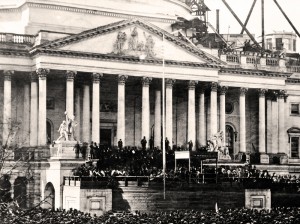 Newspapers across the country published President Abraham Lincoln’s first Inaugural Address in March 1861, but not all included the correct version. Editors in New Orleans had, as the Chicago (IL) Tribune explained, “horribly botched” the speech. Not only had “words [been] altered,” but sentences [were] cut in two in the middle and other sentences [were] run together.” As a result, Lincoln’s speech had been turned “into a ridiculous jumble and mass of nonsense.” While Tribune editor Joseph Medill knew from experience that “a long document [rarely] is transmitted over the wires without undergoing more or less transformation,” he believed in this case that New Orleans editors deliberately included errors in order to further their disunion agenda. “Evidently the conductors of the secession press are unwilling that the people whom they have hurried into rebellion without a cause, shall have the opportunity of learning the truth or of listening to exhortations of loyalty,” as Medill concluded. The only “parallel instance of meanness” that Medill could recall had occurred during the Lincoln-Douglas debates in 1858. As the Tribune noted in September 1858, Democratic editors told their reporters “to report [Lincoln’s speeches] incorrectly, to leave out words and sentences, and otherwise to mutilate his arguments so as to destroy their force and effect on the minds of those who read the Douglas papers.” You can read more about the Lincoln-Douglas debates in Michael Burlingame’s “Mucilating Douglas and Mutilating Lincoln: How Shorthand Reporters Covered the Lincoln-Douglas Debates of 1858,” Lincoln Herald (1994) and Allen C. Guelzo’s Lincoln and Douglas: The Debates That Defined America (2008). As for President Lincoln’s First Inaugural Address, see chapter 3 of Douglas L. Wilson’s Lincoln’s Sword: The Presidency and the Power of Words (2006).
Newspapers across the country published President Abraham Lincoln’s first Inaugural Address in March 1861, but not all included the correct version. Editors in New Orleans had, as the Chicago (IL) Tribune explained, “horribly botched” the speech. Not only had “words [been] altered,” but sentences [were] cut in two in the middle and other sentences [were] run together.” As a result, Lincoln’s speech had been turned “into a ridiculous jumble and mass of nonsense.” While Tribune editor Joseph Medill knew from experience that “a long document [rarely] is transmitted over the wires without undergoing more or less transformation,” he believed in this case that New Orleans editors deliberately included errors in order to further their disunion agenda. “Evidently the conductors of the secession press are unwilling that the people whom they have hurried into rebellion without a cause, shall have the opportunity of learning the truth or of listening to exhortations of loyalty,” as Medill concluded. The only “parallel instance of meanness” that Medill could recall had occurred during the Lincoln-Douglas debates in 1858. As the Tribune noted in September 1858, Democratic editors told their reporters “to report [Lincoln’s speeches] incorrectly, to leave out words and sentences, and otherwise to mutilate his arguments so as to destroy their force and effect on the minds of those who read the Douglas papers.” You can read more about the Lincoln-Douglas debates in Michael Burlingame’s “Mucilating Douglas and Mutilating Lincoln: How Shorthand Reporters Covered the Lincoln-Douglas Debates of 1858,” Lincoln Herald (1994) and Allen C. Guelzo’s Lincoln and Douglas: The Debates That Defined America (2008). As for President Lincoln’s First Inaugural Address, see chapter 3 of Douglas L. Wilson’s Lincoln’s Sword: The Presidency and the Power of Words (2006).
1
Dec
10
Journal Divided featured on C-SPAN
Posted by sailerd Published in Antebellum (1840-1861), Recent Scholarship, Video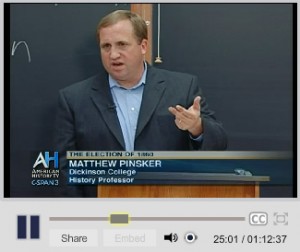 “American History TV” on C-SPAN 3 featured an episode inside the classroom of House Divided Project co-director Matthew Pinsker. C-SPAN cameras followed Pinsker as he led a discussion about Abraham Lincoln and the election of 1860 for a class at Dickinson College in Carlisle, PA. During the session, Pinsker premiered a documentary short film recently created for Journal Divided. “Honest Abe” is one of six videos created to support new interactive essays based on excerpts from the unedited manuscript of Michael Burlingame’s Abraham Lincoln: A Life (2008). Other essays include “Writing Lincoln’s Lives,” “Railsplitter,” and “Make No Contracts.”
“American History TV” on C-SPAN 3 featured an episode inside the classroom of House Divided Project co-director Matthew Pinsker. C-SPAN cameras followed Pinsker as he led a discussion about Abraham Lincoln and the election of 1860 for a class at Dickinson College in Carlisle, PA. During the session, Pinsker premiered a documentary short film recently created for Journal Divided. “Honest Abe” is one of six videos created to support new interactive essays based on excerpts from the unedited manuscript of Michael Burlingame’s Abraham Lincoln: A Life (2008). Other essays include “Writing Lincoln’s Lives,” “Railsplitter,” and “Make No Contracts.”
You can watch the full 75-minute episode on C-SPAN’s website.
29
Nov
10
Cleveland (OH) Herald & the USCT
Posted by sailerd Published in Civil War (1861-1865), Historic Periodicals Themes: Battles & Soldiers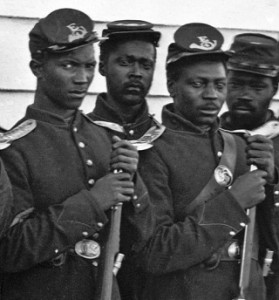 After Confederates shelled Fort Sumter on April 12, 1861, President Abraham Lincoln called for volunteers to restore order. Many northerners responded and rushed to create volunteer regiments. Yet when African Americans offered to serve, northern officials turned them down. After Ohio Governor William Dennison denied a request, the Cleveland Herald called his decision “eminently proper.” While the Herald did not want to “impugn the motives of those…who wish to raise military companies,” the editor believed that “the enlistment of colored troops would dampen, if not kill, the ardor of the masses now rushing to arms.” The Herald was also concerned that such action “would embitter the present contest and render utterly hopeless any prospect of peace.” Two years later, however, the War Department authorized the creation of the United States Colored Troops. Within months new USCT regiments were participating in battles, including those at Milliken’s Bend and Fort Wagner. The Cleveland Herald joined other northern newspapers which changed their editorial stance on African Americans in the military and even supported the call for USCT troops to receive pay equal to white soldiers. After Congress passed the necessary legislation in 1864, the Herald noted that “this simple act of justice has been quite too long delayed.” Joseph T. Glatthaar’s Forged in Battle: The Civil War Alliance of Black Soldiers and White Officers (1990), Howard C. Westwood’s Black Troops, White Commanders and Freedmen During the Civil War (1992), and John David Smith’s Black Soldiers in Blue (2002).
After Confederates shelled Fort Sumter on April 12, 1861, President Abraham Lincoln called for volunteers to restore order. Many northerners responded and rushed to create volunteer regiments. Yet when African Americans offered to serve, northern officials turned them down. After Ohio Governor William Dennison denied a request, the Cleveland Herald called his decision “eminently proper.” While the Herald did not want to “impugn the motives of those…who wish to raise military companies,” the editor believed that “the enlistment of colored troops would dampen, if not kill, the ardor of the masses now rushing to arms.” The Herald was also concerned that such action “would embitter the present contest and render utterly hopeless any prospect of peace.” Two years later, however, the War Department authorized the creation of the United States Colored Troops. Within months new USCT regiments were participating in battles, including those at Milliken’s Bend and Fort Wagner. The Cleveland Herald joined other northern newspapers which changed their editorial stance on African Americans in the military and even supported the call for USCT troops to receive pay equal to white soldiers. After Congress passed the necessary legislation in 1864, the Herald noted that “this simple act of justice has been quite too long delayed.” Joseph T. Glatthaar’s Forged in Battle: The Civil War Alliance of Black Soldiers and White Officers (1990), Howard C. Westwood’s Black Troops, White Commanders and Freedmen During the Civil War (1992), and John David Smith’s Black Soldiers in Blue (2002).

